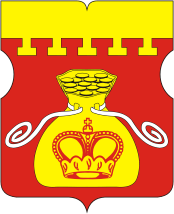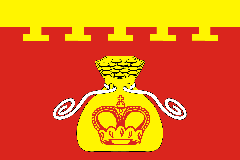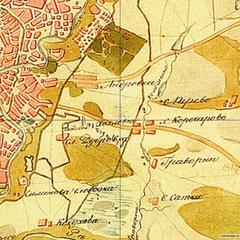
Nizhegorodsky District Moscow: Visiting Hours, Tickets, and Historical Sites Guide
Date: 14/06/2025
Introduction: Discover Nizhegorodsky District’s History and Cultural Significance
Nizhegorodsky District, set within Moscow’s South-Eastern Administrative Okrug, is a compelling destination where the city’s industrial past meets contemporary urban renewal. Known for its pre-revolutionary merchant houses, Soviet-era factories, and emerging creative clusters, this district offers a unique perspective on Moscow’s evolution. Landmarks such as Nizhegorodskaya Street, the historic Nizhegorodsky Railway Station, and the Church of St. Nicholas in Kuznetsy create a rich tapestry of architectural and social history, while vibrant parks and repurposed industrial spaces offer recreation and cultural experiences.
Accessibility is prioritized, with multiple metro stations, ramps, and elevators ensuring ease of movement for all visitors. English and Russian guided tours delve into the district’s industrial heritage and creative transformation, making Nizhegorodsky accessible and engaging for international travelers. For up-to-date visiting hours, tickets, and event information, consult official resources like the Moscow City Tourism Portal, Moscow Metro official site, and Official Moscow City Website. Enhance your visit with the Audiala app, offering audio guides and insider tips for exploring the district’s hidden gems (News18, Rough Guides, Moscow.Info).
Table of Contents
- Introduction to Nizhegorodsky District
- What to Expect When Visiting
- Historical and Cultural Highlights
- Practical Travel Tips
- Frequently Asked Questions (FAQ)
- Plan Your Visit: Links and Resources
- Exploring Nizhegorodsky District: What to See and Do
- Visitor Information: Hours, Tickets, and Tours
- Cultural and Social Highlights
- Sustainability and Green Initiatives
- Unique Experiences and Insider Tips
- Visiting the Kremlin: History, Tickets, and Visitor Guide
- Summary & Call to Action
- References
What to Expect When Visiting Nizhegorodsky District
Opening Hours and Access
- Parks & Outdoor Spaces: Open daily, typically 6:00 AM – 11:00 PM, free entry.
- Museums & Venues: Usually 10:00 AM – 5:00/8:00 PM, closed Mondays; check each venue for specifics and ticketing.
- Churches: Open daily; Church of St. Nicholas 9:00 AM – 6:00 PM, free admission.
Getting There: Transport and Accessibility
- Metro: Served by Nizhegorodskaya and Volgogradsky Prospekt stations (Moscow Metro official site).
- MCC (Moscow Central Circle): Provides quick citywide connections.
- Surface Transport: Buses, trams, and taxis are widely available.
- Accessibility: Ramps and elevators at major stations and venues. Check Moscow Metro official site for full accessibility info.
Guided Tours and Visitor Services
- Guided Tours: Available in English and Russian, focusing on industrial heritage, urban renewal, and local culture. Booking in advance is recommended, especially during festivals or peak seasons.
- Visitor Centers: Provide maps, schedules, and tourist information.
Historical and Cultural Highlights
Nizhegorodsky Railway Station
A symbol of Moscow’s 19th-century transport legacy, the station connects the city’s industrial heritage to its modern identity. Photogenic and historically important, it remains a focal point for train enthusiasts and history buffs.
Soviet Industrial Architecture
Explore preserved factories and worker housing that illustrate the district’s industrial roots. Many have been transformed into creative and business spaces, blending historical character with contemporary use.
Urban Renewal and Creative Clusters
Repurposed industrial buildings now host art studios, galleries, workshops, and event spaces. The “Nizhegorodka” creative cluster stands out for art exhibitions and cultural festivals (News18).
Parks and Open Spaces
Nizhegorodsky Park is the district’s primary green space, featuring landscaped paths, playgrounds, and community events. It’s open daily and free to enter (Moscow.Info).
Practical Travel Tips
- Best Visiting Season: Late spring to early autumn for outdoor exploration and events.
- Dining: Enjoy classic Russian dishes and pastries at local cafés and bakeries—try pirozhki at district bakeries (The Broke Backpacker).
- Markets: Nizhegorodsky Market is renowned for fresh produce and regional specialties.
- Photography: The railway station, historic streets, and industrial zones offer striking photo opportunities.
- Weather: Dress for walking and check forecasts; many attractions are outdoors.
- Transport: Use metro and buses to avoid parking challenges.
Frequently Asked Questions (FAQ)
Q: Are there entry fees for visiting Nizhegorodsky District?
A: Most parks and public spaces are free. Museums and galleries have ticketed entry, typically 200–500 RUB.
Q: Is Nizhegorodsky District safe?
A: Yes, with standard urban safety precautions.
Q: Are English-language tours available?
A: Yes, but book ahead for the best selection.
Q: Is the district accessible for those with mobility challenges?
A: Most new developments and major venues have ramps and elevators.
Q: Where can I find official visitor information?
A: Moscow City Tourism Portal and Official Moscow City Website.
Plan Your Visit: Useful Links and Resources
- Official Moscow City Website
- Moscow Metro Information
- Nizhegorodsky District Map and Guide
- Local Events and Cultural Calendar
- Museum of Moscow Railways
- Nizhegorodka Creative Cluster
What to See and Do in Nizhegorodsky District
Architectural and Historical Landmarks
- Nizhegorodskaya Street: Features preserved merchant houses and pre-revolutionary architecture (Moscow.Info).
- Church of St. Nicholas in Kuznetsy: A Moscow Baroque gem, open daily, free entry (Rough Guides).
- Moscow Railway Workshops: Important for Russia’s railway history; some buildings house the Museum of Moscow Railways (bibliotekanauki.pl).
Cultural and Recreational Spaces
- Nizhegorodsky Park: Landscaped, family-friendly, and host to events (Moscow.Info).
- Creative Clusters: Galleries, artist studios, and performance spaces in repurposed factories (News18).
- Local Theatres: Small venues for drama, music, and children’s performances (Rough Guides).
Museums and Educational Sites
- Museum of Moscow Railways (Branch): Exhibits vintage locomotives and railway history; open Tue–Sun (bibliotekanauki.pl).
- Local History Exhibition Halls: Rotating displays and oral history events (Moscow.Info).
Religious and Spiritual Sites
- Orthodox Churches and Chapels: In addition to St. Nicholas, several smaller chapels welcome visitors (Rough Guides).
- Jewish Community Center: Offers educational and cultural programs.
Markets, Shopping, and Gastronomy
- Nizhegorodsky Market: Fresh food and regional specialties (The Broke Backpacker).
- Cafés and Restaurants: Mix of classic and modern Russian cuisine.
Seasonal Events and Festivals
- Moscow Estates Festival: Historic houses and gardens open for tours and concerts (News18).
- Local Holiday Celebrations: Maslenitsa, Victory Day, and more, with folk performances and fairs (bibliotekanauki.pl).
Urban Infrastructure and Accessibility
- Transport Links: Metro, MCC, buses, and trams connect Nizhegorodsky with the rest of Moscow (Rough Guides).
- Pedestrian-Friendly Zones: Improved sidewalks, lighting, and signage in Russian and English.
Unique Experiences and Insider Tips
- Join a Themed Walking Tour: Local guides offer deep dives into industrial history, architecture, and local stories (Moscow.Info).
- Explore Hidden Courtyards and Murals: Discover mosaics and art in side streets.
- Attend Community Events: Check event calendars for open-air concerts and festivals.
Visiting the Kremlin: History, Tickets, and Visitor Guide
History and Significance
While the Kremlin commonly refers to Moscow’s fortified complex in the city center, it is easily accessible from Nizhegorodsky District and represents the pinnacle of Russian history and architecture. With origins in the 15th century, its cathedrals, palaces, and the Armoury Chamber are essential stops for any visitor. The Kremlin is a UNESCO World Heritage Site and houses Russia’s most significant state and religious treasures.
Visiting Hours and Tickets
- Hours: Tuesday–Sunday, 10:00 AM – 5:00 PM (closed Mondays).
- Tickets: Kremlin grounds ~700 RUB, Armoury Chamber extra (~1,000 RUB). Discounts for students, seniors, and children.
- Where to Buy: Online or at on-site ticket offices; booking ahead is recommended (Official Kremlin Website).
Getting There
- Metro Access: Okhotny Ryad, Ploshchad Revolyutsii, Teatralnaya stations.
- Public Transport: Troika smart card accepted on all modes.
Visitor Tips
- Security: Allow time for security checks.
- Photography: Permitted outdoors, restricted in some interiors.
- Accessibility: Most major sites are accessible; some historic buildings may have limitations.
- Guided Tours: Available in English and Russian.
- Nearby Sites: Red Square, St. Basil’s Cathedral, State Historical Museum.
Special Events and Exhibitions
Check the Kremlin’s website for current exhibitions and seasonal events.
Summary & Call to Action
Nizhegorodsky District is an ideal destination for travelers seeking a blend of Moscow’s historic charm and modern vibrancy. Its industrial heritage, creative clusters, and green spaces create a living example of urban renewal. With accessible transport, affordable tickets, and diverse attractions, the district is well-suited for all visitors. The nearby Kremlin adds a monumental experience to your itinerary.
For the latest updates and to maximize your experience, use the Official Moscow Tourism Website, Moscow Metro Information, and the Official Kremlin Website. Download the Audiala app for interactive maps, guided audio tours, and real-time event information. Follow us on social media for inspiration and the latest news.
References
- Moscow City Tourism Portal
- Moscow Metro official site
- Official Moscow City Website
- Moscow.Info
- Rough Guides – Moscow Travel Guide
- News18 – Moscow’s Tourism Renaissance
- bibliotekanauki.pl – Museum of Moscow Railways Article
- The Broke Backpacker – Moscow Itinerary
- Official Kremlin Website






















































































































































































































































































